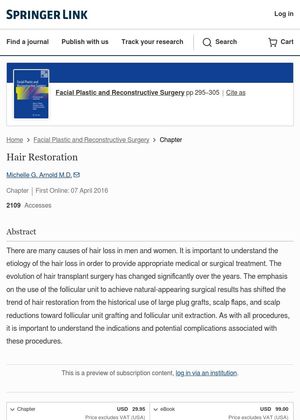Hair Restoration: An Overview of Anatomy, Causes, and Treatments
January 2016
in “
Springer eBooks
”

TLDR The document concludes that there are various causes and treatments for hair loss, with hair transplantation being a notable option.
The document from 2016 provides an overview of hair restoration, including the anatomy of the scalp, hair follicles, the hair growth cycle, and causes and treatments for hair loss. It notes that scalp hair grows about 1 mm every 3 days and up to 100 hairs are shed daily. Androgenic alopecia (AGA) is identified as the most common cause of hair loss, with other types including alopecia areata, triangular alopecia, telogen effluvium, anagen effluvium, and scarring alopecias. Treatments mentioned range from observation to hair transplantation, with medical treatments including minoxidil and finasteride. The document details surgical techniques like Follicular Unit Grafting (FUG) and Follicular Unit Extraction (FUE), the latter of which avoids a linear donor scar and has improved transection rates with powered punch devices. Postoperative expectations include temporary hair loss with new growth starting in 3-4 months. Older methods like scalp reductions and flaps are also discussed, along with potential complications of surgical hair restoration.


















